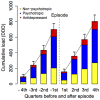Change in access to prescribed medication following an episode of deliberate self-poisoning: a multilevel approach
- PMID: 24854351
- PMCID: PMC4031187
- DOI: 10.1371/journal.pone.0098086
Change in access to prescribed medication following an episode of deliberate self-poisoning: a multilevel approach
Abstract
Objective: Patients with a history of deliberate self-poisoning (DSP) are prescribed a greater amount of medication than the general public. DSP is the most robust risk factor for repeat episodes of DSP and subsequent death by suicide, and one might therefore expect that access to prescribed medication would be reduced following an episode of DSP. However, it is unclear whether access to prescribed medication changes after an episode of DSP. The objectives of this study were to investigate changes in 1) overall, psychotropic, non-psychotropic and the psychotropic subgroup antidepressant prescribed medication availability in DSP patients following an episode of DSP, 2) prescribing of the medication ingested in the episode, and 3) potential effects of gender, age and repeater status on such change.
Methods: The design was longitudinal. We included 171 patients admitted for DSP between January 2006 and March 2007. Data on patients' prescriptions prior to admission were retrieved from The Norwegian Prescription Database. The outcome measure was the difference between medication load in the year following compared to the year prior to the DSP episode.
Results: There was a significant increase in total medication load following DSP, including both psychotropic and non-psychotropic medication. Antidepressant medication load remained stable. There was a tendency for access to drugs ingested in the episode to increase following the episode, albeit not significantly. Medication load increased with age across all medication groups irrespective of time period and gender.
Conclusions: The findings show that physicians do not curb prescribing to patients who have recently deliberately self-poisoned. Moreover, they highlight the need for cautious and judicious prescribing for these patients, in combination with psychological and social interventions.
Conflict of interest statement
Figures




References
-
- Gjelsvik B, Heyerdahl F, Hawton K (2012) Prescribed medication availability and deliberate self-poisoning: a longitudinal study. J Clin Psychiatry 73: e548–554. - PubMed
-
- Gjelsvik B, Heyerdahl F, Hawton K (2013) Deliberate self-poisoning with prescribed drugs is not related to medical severity of acts. J Clin Psychiatry 74: 630. - PubMed
-
- Bergen H, Hawton K, Waters K, Ness J, Cooper J, et al. (2012) Premature death after self-harm: a multicentre cohort study. Lancet 380: 1568–1574. - PubMed
-
- Bjornaas MA, Jacobsen D, Haldorsen T, Ekeberg O (2009) Mortality and causes of death after hospital-treated self-poisoning in Oslo: a 20-year follow-up. Clin Toxicol 47: 116–123. - PubMed
Publication types
MeSH terms
LinkOut - more resources
Full Text Sources
Other Literature Sources
Medical
Miscellaneous

